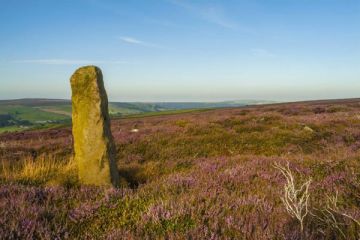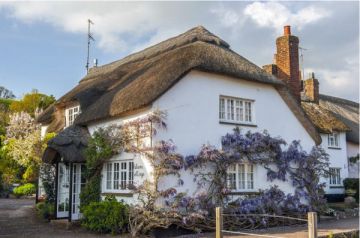
The name Sandford perfectly describes the history of this pretty Devon village. The name comes from a sandy ford across the brook at the base of the hill on which the village stands.
In AD 739 King Ethelbeard granted land to found a monastery near Sandford, at a place called Creedy. This grant was followed in AD 930 by King Athelstan, who gave 3 hides of land in western Sandford to the first Bishop of Crediton. Later that same century King Ethelred gave the eastern part of his Sandford estates (about 2 hides in total) to Bishop Alfwod of Crediton.
We do not know exactly how much land was involved in these 2 grants, as a hide could vary in widely in size. A hide was enough to support one family for a year, and usually averaged between 60-80 acres.
When the bishops moved their see to Exeter in 1050 Sandford was transferred to Holy Cross Church in Crediton. It was possibly around this time, between 1030-1040, that the first church was built in Sandford. It may have been erected by Bishop Lyfing to his patron saint, Swithun.

The 11th-century church was rebuilt around 1200, and the lowest parts of the walls and base of the tower remain from this early 13th-century building.
Murder in St Swithuns
In the early 12th century, some time during the reign of Henry I (1100-1135) a pair of men began to fight during Mass. One was killed in the affray, and as a result of the murder, the entire church was closed down until 1137. This tragic incident is depicted in a Tudor carved capital, where the mason shows a pair of children pulling each others hair.
By 1437 so many parishioners of Crediton were attending services at St Swithun's that the bishop of the time closed the church down again, forcing residents to worship at Holy Cross in Crediton. Sandford's church was not reopened until 1523.
When the church reopened it was only after renovation in the fashionable Tudor style, with wagon roofs extending the full length of both aisles. Later in the 16th century, the beautifully carved pews and bench ends were installed. The bench ends are a superb example of exuberant Elizabethan carving, with symbols ranging from a man smoking a pipe to several depictions of the pagan Green Man symbol. One intriguing carving shows what appears to be an Aztec Indian.
In 1657 John Davie of Creedy Park built the west gallery to provide seating for children from the local poorhouse. He also installed a squire's pew for himself, his family, and their servants.

In 1748 a ring of 5 bells was installed, cast by William Evans of Chepstow. A treble bell was added in 1949. Until the 19th century, St Swithuns was designated a chapel of ease to Holy Cross church. In 1847 an extensive rebuilding took place; the roof was raised and clerestory windows inserted to make the interior lighter.
The chancel was extended, and the burial ground outside the church consecrated for the first time. The Davie family pews were removed and replaced with ordinary pews, so the Davie servants had to sit at the back of the church in regular pews.
After World War One a memorial screen was installed between the nave and chancel to commemorate the fallen in the Great War Look for the date, which shows 1919 rather than the more traditional 11 November 1918. The reference to 1919 is accurate, as the war technically did not end until the official peace treaty was signed in that year.
Perhaps the most interesting memorial is a 1585 brass to Mary Carew, and a 17th-century memorial to the Davie family on the north wall of the chancel. Even more ornate is a white marble monument to Sir Humphrey Davie (d. 1840), with carvings depicting the tale of the Good Samaritan.
The font is probably early Victoria, and the pulpit dates to the late 19th century. Most of the glass was installed in the 1880s. The tower clock was made in 1815 but not for St Swithuns; it was installed in All Saints church in Kenton and only brought to Sandford in 1922.
St Swithuns is an attractive country church, set in a very pretty village, well worth visiting for its wonderful collection of 16th-century carved bench ends.


